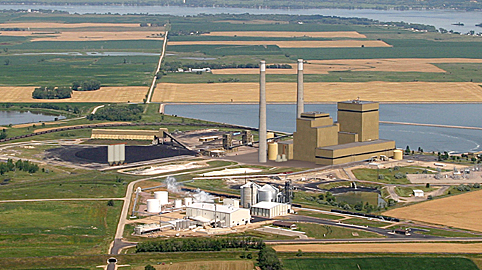Another wind-transmission-coal deal … sigh…
October 21st, 2005
So we have another deal, for transmission AND a coal plant — backing off against the new Big Stone II coal plant in exchange for “transmission for wind.” Right… I’m still working on getting a copy of the agreement.

Funny, there’s no mention of the Belfield plant that the MTEP06 plan talks about connecting on this line… that report says in point 2 (emphasis added):
6.1 Regional projects or Study Areas of Focus:
? CAPX (Incorporates prior Northwest Area Exploratory Project) ? Three options are to
be pursued:1. Coal fields of North Dakota to Fargo to Benton County outside of the Twin Cities
2. Belfield, North Dakota (site of a new 500 MW coal plant) to Ellendale, South
Dakota to Big Stone area to Granite Falls to Blue Lake, Minnesota
3. Cross link from Ellendale to Fargo
Here’s another link to the Belfield plant, minutes from the Lignite Research Council.
Oh great, as if mercury and emissions sufficient to knock your SOx and NOx off isn’t enough, the Belfield coal has uranium in it! Check this: Nuclear Decommissioning – Belfield Ashing Facility Site
FINALLY – Here’s the article in the Sioux Falls’ Argus Leader — I used to read it regularly at the 399 mile marker on Saturday mornings…
Deal ‘opens the door’ to wind powerBEN SHOUSE
bshouse@argusleader.comArticle Published: 10/21/05
A coal-fired power plant in the works near Milbank could spawn new wind farms in South Dakota, a possible source of renewable energy and of millions of dollars in fees for landowners and tax revenue for the state.
The power companies building the Big Stone II plant announced Thursday that they will build extra electricity transmission capacity into their project, making room on the grid for wind farms in South Dakota or Minnesota.
The plant itself will generate 600 megawatts – enough to power 300,000 homes or more – and a new transmission line will add 800 to 1,000 megawatts of spare capacity on top of that, said Mark Rolfes of Otter Tail Power Co.
“Essentially, this opens the door,” said Public Utilities Commissioner Dusty Johnson in Pierre.
“This is going to help wind farm development in many places in South Dakota because the transmission grid is so interconnected.”
The companies also will add air pollution controls to the existing Big Stone plant as well as the new plant, resulting in no increases in most types of air pollution, Rolfes said.
Deanna White of the Sierra Club’s Sioux Falls office said she appreciates the effort. But she is not convinced the wind energy benefits will materialize and questions the wisdom of burning coal in the first place.
“Ultimately, we don’t believe that investing in coal-fired power plants is the way to go,” she said. “We believe that the best choice would be to invest in renewable energy and conservation measures.”
The Izaak Walton League’s Midwest office in St. Paul and several other advocacy groups also oppose the new plant.
In June, seven power companies announced plans to build the $1 billion plant between 2007 and 2011, to serve customers in northeast South Dakota, and in North Dakota and Minnesota.
It would be the largest single investment ever made in South Dakota.
Rolfes said Thursday’s announcement was partly in response to environmental groups concerned about pollution from a new coal plant, and the desire of citizens to see the region’s tremendous potential for wind power realized.
“The transmission’s biggest benefit is hopefully the public acceptance that we’re trying to do the right thing,” he said.
Johnson said the move made Public Utilities Commission approval more likely. That process probably will wrap up sometime next year.
“The two big announcements they made today – excess transmission capacity and a lot more pollution control – is going to make it a lot easier for this commission to see this project as good for South Dakota,” he said.
But White of the Sierra Club said it is not clear that the extra capacity would all go for wind.
“They’re very dedicated to the idea of getting this plant built and getting it permitted. I don’t believe that they’re lying, I just think that they’re putting the best spin on things,” she said.
Federal rules dictate that excess transmission capacity goes to the first power source able to use it, so there is no way to ensure it will go to wind power, said Steve Schultz of Missouri River Energy Services. But he said wind is the most likely user because power companies do not have any other sources planned.
The new plant will be right next to an existing 425-megawatt plant, making it possible to remove air pollution from both the old and the new plants.
For example, a scrubber technology called “wet flue gas desulfurization” will remove about 95 percent of the sulfur dioxide emissions, which contribute to acid rain. That means emissions of both plants will be 15 percent of what Big Stone I emits today, Rolfes said.
A technology called selective catalytic reduction will remove nitrogen oxides, which cause smog and acid rain.
Rolfes said because technology is changing, it is not clear what kind of controls the new plant will have for mercury, a pollutant that collects in fish and can cause brain defects in fetuses and children. He said he expects mercury emissions of both plants to be less than those of Big Stone I.
Frank O’Donnell, president of Clean Air Watch in Washington, said most of those technologies are state of the art, but he was disappointed by the lack of a clear plan for mercury.
“It’s actually a little alarming to hear that they’re hedging their bets on what they’re going to do about mercury,” he said. “There is technology being sold now commercially that can take 80 or 90 percent of mercury out of systems.”
Reach Ben Shouse at 331-2318.
Leave a Reply